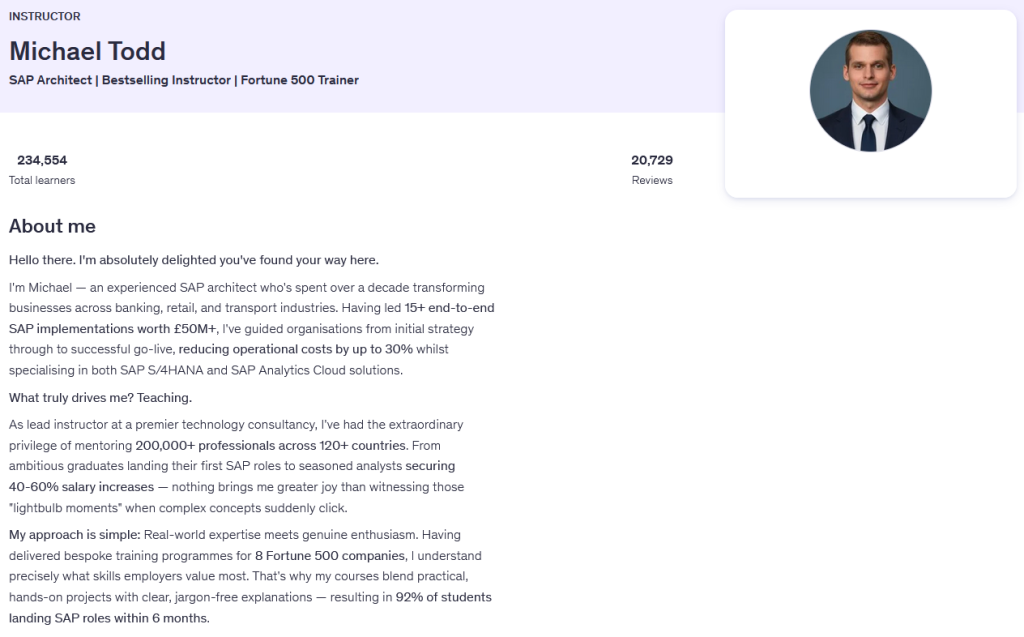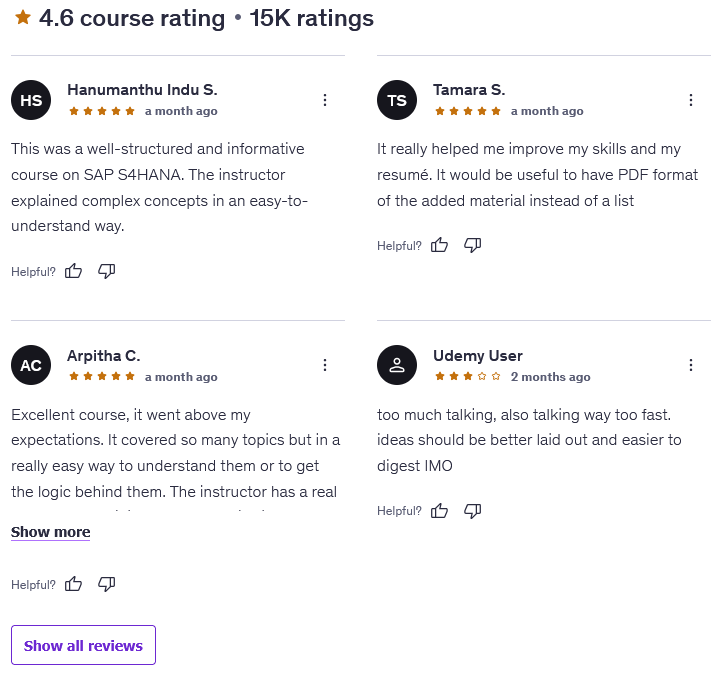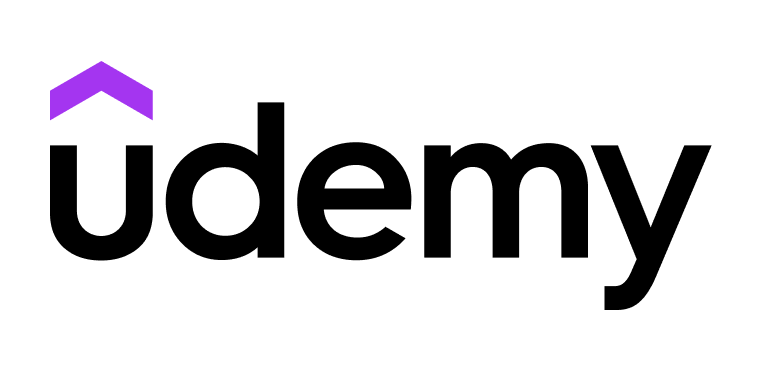If you’ve ever looked at SAP and thought, “This looks insanely complicated,” you’re not alone. But The Ultimate SAP S/4HANA Course 2025: From Zero to Expert aims to fix exactly that. This course promises to take absolute beginners and turn them into confident SAP users who can navigate real business processes, understand multiple modules, and even prep for certification — all without prior SAP experience.
With over 200 hands-on scenarios, real-world demos, and coverage of everything from FI and CO to PP, MM, SD, HCM, Fiori, HANA, analytics, and even S/4HANA’s 2025 updates… this one is packed. The question is: does it actually deliver? Let’s break it down.
Instructor Reputation
One of the biggest strengths of this course is the instructor behind it — Michael Todd, a name you’ll see all over the SAP corner of Udemy. And honestly, when you look into his background, it becomes pretty clear why so many students trust him to teach something as notoriously complex as SAP.

Michael isn’t just someone who has “used SAP before.” He’s an SAP architect with over a decade of enterprise-level experience, and not just small projects. We’re talking 15+ full scale, end-to-end SAP implementations — multi-industry, multi-module transformations worth tens of millions of pounds. He’s worked with massive organizations across banking, transport, and retail, guiding them from high-level strategy all the way down to go-live execution and post-launch optimization. When someone has that level of experience, you feel it in the way they teach.
But what sets him apart, and what students notice immediately, is his communication style. Plenty of SAP experts know their stuff, but very few can explain why SAP works the way it does without falling into a swamp of acronyms and dense terminology. Michael breaks it all down with a smooth, conversational approach — the kind of teaching that makes you think, “Ohhhh, that finally makes sense.”
His teaching record also speaks for itself:
- 200,000+ students worldwide
- 20,000+ reviews
- A consistent 4.5 instructor rating
- Mentored learners in 120+ countries
- Helped thousands transition into SAP roles with 40–60% pay bumps
He’s also the kind of instructor who clearly enjoys what he does. There’s genuine enthusiasm in his explanations, and you can tell he’s had those front-row “lightbulb moments” with students for years. He often ties lessons back to real consulting stories — not in a braggy way, but in a “here’s what actually happens on projects and how this concept matters in the real world” way. That’s the kind of detail you can only get from someone who’s lived inside SAP landscapes for years.
Another huge plus: Michael keeps his content current. SAP changes fast, especially with S/4HANA cloud updates rolling out constantly. Many SAP courses on Udemy still teach versions from 2018–2020. This one is updated for 2025, and Michael goes out of his way to incorporate UX changes, app redesigns, release strategy updates, and new SAP Activate practices. You’re not learning outdated screens that no longer exist.
Between the depth of his consulting experience, the scale of his teaching track record, and his ability to break down difficult concepts, he’s exactly the kind of instructor you want guiding you through an “absolute beginner to expert” journey in SAP.
Course Structure
The structure of The Ultimate SAP S/4HANA Course 2025: From Zero to Expert is one of its biggest competitive advantages. A lot of SAP courses dump you straight into transactions without explaining how SAP works as a whole. This one takes the opposite approach: it’s deliberately structured so a complete beginner can follow the progression logically, slowly building a mental map of SAP’s world before diving into the complex processes.

Here’s how the course flows and why it works so well:
1. Starting with the Big Picture
The course begins with the absolute fundamentals:
- What ERP systems do
- Where SAP fits in the business world
- How S/4HANA differs from ECC
- Why companies invest millions into SAP systems
- How different modules connect behind the scenes
This gives beginners a sense of orientation before encountering any screens or transactions. A lot of SAP confusion happens simply because people jump in without this context.
2. Understanding Navigation Early On
Before touching business processes, Michael teaches:
- SAP GUI basics
- Fiori Launchpad navigation
- Fiori tiles vs. classic transaction codes
- The differences in UX between ECC and S/4HANA
This is crucial because real SAP environments use a mix of both. By learning navigation early, students feel more confident before the “heavier” sections begin.
3. Deep-Dive Into Core Modules
The course then moves into the essential business modules:
- FI (Financial Accounting)
- CO (Controlling)
- MM (Materials Management)
- SD (Sales & Distribution)
- PP (Production Planning)
- HCM (Human Capital Management)
Each module isn’t just explained theoretically — you actually watch and replicate business processes within SAP. This includes:
- Creating sales orders
- Posting goods receipts
- Running MRP
- Managing cost centers
- Creating purchase orders
- Performing invoice verification
- Managing HR master data
The progression is intentionally logical: procurement flows into inventory, which feeds into production, which ties into sales, all of which link back to finance. By the time you finish, you understand not just how to navigate SAP, but why each module exists and how they work together.
4. Real-World End-to-End Scenarios
One of the strongest elements is the 200+ business scenarios sprinkled throughout the course. These are:
- Realistic
- Sequential
- Job-relevant
- Based on how SAP is actually used in companies
Instead of isolated exercises, you get holistic process flows like:
- Order-to-Cash
- Procure-to-Pay
- Hire-to-Retire
- Plan-to-Produce
This is exactly how SAP is used on real projects — so the hands-on nature is extremely practical.
5. Technical Fundamentals
Unlike many beginner courses, this one also introduces the “behind-the-scenes” side of SAP:
- Background jobs
- User admin
- Print management
- System monitoring
- Remote function calls
- Embedded analytics
- SAP HANA basics
You don’t become a Basis admin from this, but you do gain a high-level understanding of how SAP runs — which gives beginners an advantage when interviewing or transitioning into consulting.
6. S/4HANA Cloud & Licensing
This is a major differentiator. Many SAP courses skip cloud architecture entirely. Here, Michael covers:
- Public vs private cloud
- On-premise vs hybrid
- Subscription models
- Cloud migration strategies
- Release cycles
- Licensing fundamentals
Given how many companies are moving to S/4HANA Cloud, this section is incredibly valuable.
7. Personal SAP System Setup
The course even guides you through setting up your own S/4HANA practice system using Google Cloud credits. For beginners, this is huge — SAP environments are expensive and not easy to access otherwise.
8. Certification & Career Strategy
Toward the end, the course pivots from technical skills to career guidance, covering:
- Which SAP roles exist
- How to choose between functional and technical tracks
- Certification tips
- Salary expectations
- Interview preparation
- How to keep learning post-course
It’s a well-rounded, “start-to-finish” roadmap that helps students go from total beginner to job-ready mindset.
Content Quality
The content quality in The Ultimate SAP S/4HANA Course 2025: From Zero to Expert is genuinely one of its strongest aspects, especially for beginners who need clarity without being overloaded. SAP is a massive ecosystem — dozens of modules, hundreds of subprocesses, and layers of technical and functional components. Most courses either skim the surface or drown you in unnecessary details. This one strikes a balance that feels intentional, thoughtful, and beginner-friendly while still being substantial enough for someone who wants to start preparing for real SAP roles.

The first thing that stands out is how approachable everything is. Michael doesn’t assume you know anything about SAP, ERP, or even general enterprise systems. He walks you through the large concepts before zooming into the technical mechanics, which makes the entire learning journey feel structured and grounded. A lot of students get lost in SAP simply because they don’t understand what they’re looking at — but here, concepts like “master data vs transactional data,” “the SAP landscape,” “why companies choose S/4HANA,” and “how modules interact” are explained clearly before you ever press a button in the system.
Another highlight is the breadth of the content. This is not a niche or specialized SAP intro that focuses on just one module or a couple of scenarios. Instead, the curriculum covers:
- All major functional modules (FI, CO, SD, MM, PP, HCM)
- SAP architecture and system design
- SAP HANA database fundamentals
- The differences between ECC and S/4HANA
- SAP cloud deployment models
- Fiori apps and modern UX
- Background jobs and automation
- Reporting and analytics (including embedded analytics)
- System administration basics
- Licensing and cloud strategy
- Project lifecycle through SAP Activate
Most beginner courses don’t touch half of these topics, so having them in one place gives learners a more complete understanding of how SAP functions in the real world.
The hands-on demonstrations are where the course really becomes valuable. You’re not just watching high-level lectures — you’re doing things that SAP analysts, consultants, and support teams do every day. That means:
- Creating orders
- Running MRP
- Executing deliveries
- Posting goods receipts
- Managing employee data
- Running financial postings
- Conducting cost center planning
- Using Fiori app variants
- Exporting reports
- Scheduling background jobs
These scenarios feel practical, not academic, and they help you visualize what working in SAP actually looks like. Many students mention that these demos made them feel confident enough to apply for junior SAP roles or move into SAP from unrelated fields.
The course also shines because it’s up-to-date. SAP evolves constantly, especially with S/4HANA Cloud and annual release cycles. Michael incorporates 2025 features, new UX updates, refreshed Fiori layouts, and updated release strategy explanations. This matters a lot because employers expect familiarity with modern S/4HANA interfaces — not screens from 2018.
Are there downsides? A few — but nothing that breaks the experience. Some students feel the pace can move quickly in technical sections, especially when covering HANA or system administration components. And while the downloadable content is helpful, a few reviewers wished more of the supplemental materials came as PDF summaries instead of lists. But overall, those are minor notes in an otherwise very polished and digestible course.
If you want SAP content that’s modern, practical, and designed around real-world use cases — this course delivers on all fronts.
Overall Course Rating – 9.2/10
Overall, The Ultimate SAP S/4HANA Course 2025: From Zero to Expert lands at a strong 9.2/10, and that rating is based on the course’s depth, practicality, structure, and relevance to current SAP job markets. Right from the first few lessons, it’s clear this is not one of those superficial SAP intros that gives you definitions and slides without any real system use. Instead, it’s a full-guided journey through the SAP world — the kind of course that actually prepares beginners for real workflows, certification study, or even early career opportunities.

What makes the rating so high is the combination of an experienced instructor and a curriculum that feels like it was designed with purpose. Beginners especially benefit from the clarity and structure — concepts build on each other logically, and the teaching style ensures you don’t feel lost even when diving into bigger, more complicated modules like FI or PP. There’s an unmistakable polish to the pacing and order of topics, and you never feel like a section was thrown in just to pad the length.
Another factor that boosts the score is the real-world approach. SAP is only useful if you understand it in a business context, and that’s exactly how this course is taught. Instead of isolated “demo clicks,” you see end-to-end processes unfold. That means you learn SAP the way professionals actually use SAP — through business logic, not isolated transactions. When you see the full Order-to-Cash or Procure-to-Pay cycle come together, it’s much easier to connect the dots across modules.
The inclusion of SAP Cloud, HANA, Fiori, analytics, and architecture-level concepts is another major strength. Many SAP intro courses entirely skip these modern elements, but this one embraces them, giving learners a future-proof foundation. If someone wants to continue into consulting, solution architecture, or more advanced functional roles, this course gives them a head start.
That said, the course isn’t perfect — and the rating reflects that. The pace can feel brisk in some areas (especially for anyone without a technical background), and some students wished for more downloadable PDF-style guides. But these issues don’t significantly hinder the total learning experience. At worst, they make you pause and replay some segments, which is common in any technical course.
All in all, this course is one of the most comprehensive SAP beginner resources available on Udemy. It’s deep enough to be useful for career-switchers, clear enough for total beginners, and modern enough to keep you aligned with current SAP industry standards. If you’re looking to start your SAP journey, this is easily one of the best bang-for-buck options you can find.



